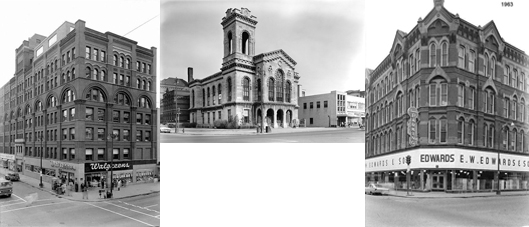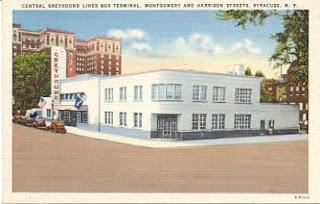To be honest, I don't know what's sadder: the knowledge that artifacts representing the pride and enthusiasm of a generation are (currently?) buried underneath this building that has barely made it fifty, let alone one hundred, years, or that bank president Warren R. Bentley was so naive to believe that his building's fate would be any different than that of the fifty-year old Warner/Post-Standard building which had been razed a mere decade earlier. —blog entry posted June 27, 2008
 |
| The apparent audience at the time capsule opening, screen shot from YNN News report |
History is littered with footnotes, and that I should become one in this story—with no contact from the OHA in regards to the capsule's opening, despite acknowledging that they knew nothing of the capsule until I discovered its existence on the second-ever entry on this blog (five years ago this week)— is slightly insulting, but not inconceivable. (In fact, I only learned of the opening last week, after reading this piece about time capsules.) That the entire Syracuse community became footnotes, at the very hands of the association whose mission is to "educate and encourage the exploration, appreciation, and utilization of the past in order to add value throughout our community," is inexcusable.
I would have never known about the time capsule had it not been for the extensive coverage of its burial in 1950, but the same cannot be said for its opening. Searches of syracuse.com, wsyr.com, cnycentral.com all come up empty, though it is unclear if reporters were not invited, no shows, or did not did not archive the coverage on their websites. (The Syracuse New Times does have a small clipping, albeit with a misspelled "histrory".) How can this be, when not only did the site of 321 South Warren Street once house both the Syracuse Herald and Post-Standard, but the documented capsule contents included a recorded commentary by E.R. Vadeboncoeur of WSYR, and copies of the all (when an actual multiple quantity existed) of the city's newspapers at the time?
The decision to put the Marcellus Observer in the tube was prompted by the suggestion that copies of every weekly newspaper published in Onondaga County during the week of January 15 be included among the capsule's contents. In addition, issues of the two Syracuse daily newspapers will be buried with the time capsule. (Marcellus Observer, January 20, 1950).
Contrast this with the coverage of opening of a century-old time capsule in Oklahoma this past April, with news reports from several local print and television outlets, video on Yahoo! News, and images of the entire capsule inventory on the Oklahoma Historical Society Facebook page. The OHA Facebook page contains only two photos from the capsule (and no live stream or tweeting of the event), with one generating this fitting comment and response:
—Cool! When was this opened?
—This was opened at 2:00 as part of our History House Party.
When the event, of course, was already history.
As the capsule opening was part of larger open house celebration—complete with a $15 ticket charge, which seems absolutely antithetical to the spirit of time capsules (even for one buried in a bank)—there apparently was no chance of any schoolchildren participating in a field trip at the museum that day, as there were on the afternoon my dad stopped by back in May 2009, to take some photos of the just-found capsule:
While I should have been excited to see photos of the capsule, I was far more taken with the kids in the background. These teens appear to have expressions of actual interest on their faces! About history! Probably because in they have grown up in a world with very little mystery left, but this copper capsule, with its dented exterior and faded print, was a real-life buried treasure. How can OHA Executive Director Gregg Tripoli speak of "creating a community identity and optimism and hope for the future" when the very hope for the future—young people—are nowhere to be seen as the capsule contents were revealed?
However, given that one of the later activities on the same day of the capsule opening was the opening of the Jean Daugherty Memorial Magic Toy Shop Room, the OHA clearly recognizes that nostalgia forms a large part of Syracuse's identity. Every article or column remembering the city of yesteryear posted on syracuse.com generates dozens—if not thousands—of responses and recollections. As Sean Kirst commented recently to a reader who remarked on the ongoing popularity of these nostalgia pieces: "I need to find some way to give readers the chance to do this [nostalgia remembrances] more routinely." Such as the opening of a time capsule, containing items from 1950 downtown Syracuse?
Granted, there was no mystery as to the contents of this capsule; the citizens of 1950 apparently did not envision that the various newspapers and periodicals placed in the time capsule would be digitized, not only removing element of surprise, but the necessity for the capsule itself, as many of the items in this capsule can be found online. Or maybe they did, as the magic of a time capsule isn't about the artifacts, but the aura: the idea that a crowd gathered in downtown Syracuse sixty-three years ago, in hopes that one day, a similar crowd would come together and remember:
 |
| Syracuse Herald-Journal, January 21, 1950 |
Granted, there was no mystery as to the contents of this capsule; the citizens of 1950 apparently did not envision that the various newspapers and periodicals placed in the time capsule would be digitized, not only removing element of surprise, but the necessity for the capsule itself, as many of the items in this capsule can be found online. Or maybe they did, as the magic of a time capsule isn't about the artifacts, but the aura: the idea that a crowd gathered in downtown Syracuse sixty-three years ago, in hopes that one day, a similar crowd would come together and remember:
A hundred years from today this time capsule, as it has been termed, will be opened and probably the Syracusans of 2050 will smile a bit at this city's status of a century before. Probably they will wonder at the comparatively primitive fashion of our lives in 1950 and think we were rather odd folks. (Syracuse Herald-Journal, January 21, 1950)
No, when it comes to primitive and rather odd folks, 2013 seems to have 1950 beat. Given the unique opportunity to stage an event that could have highlighted downtown Syracuse both past and present, gathering the younger generations who believe in Syracuse with the older who have never forgotten Syracuse, the OHA instead chose to open the capsule in a near-empty room in the middle of the work/school day, when the very community that the museum is there to serve could in no way partake in the activity. I can only ask the question that has so often been at the heart of the sixty articles I have posted on this blog over the past five years:
Why?
Why?





